
Wolf–Rayet stars, often abbreviated as WR stars, are a rare heterogeneous set of stars with unusual spectra showing prominent broad emission lines of ionised helium and highly ionised nitrogen or carbon. The spectra indicate very high surface enhancement of heavy elements, depletion of hydrogen, and strong stellar winds. The surface temperatures of known Wolf–Rayet stars range from 20,000 K to around 210,000 K, hotter than almost all other kinds of stars. They were previously called W-type stars referring to their spectral classification.
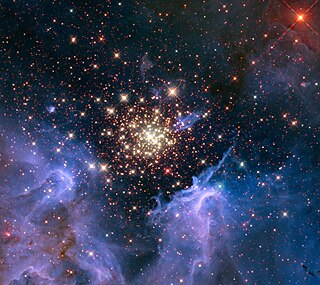
Sher 25 is a blue supergiant star in the constellation Carina, located approximately 25,000 light years from the Sun in the H II region NGC 3603 of the Milky Way. It is a spectral type B1Iab star with an apparent magnitude of 12.2. Its initial main sequence mass is calculated at 60 times the mass of the Sun, but a star of this type will have already lost a substantial fraction of that mass. It is unclear whether Sher 25 has been through a red supergiant phase or has just evolved from the main sequence, so the current mass is very uncertain.

WR 7 is a Wolf–Rayet star in the constellation of Canis Major. It lies at the centre of a complex bubble of gas which is shocked and partially ionised by the star's radiation and winds.

WR 25 is a binary star system in the turbulent star-forming region the Carina Nebula, about 6,800 light-years from Earth. It contains a Wolf-Rayet star and a hot luminous companion and is a member of the Trumpler 16 cluster. The name comes from the Catalogue of Galactic Wolf–Rayet Stars.
HD 38282 is a massive spectroscopic binary star in the Tarantula Nebula, consisting of two hydrogen-rich Wolf-Rayet stars.
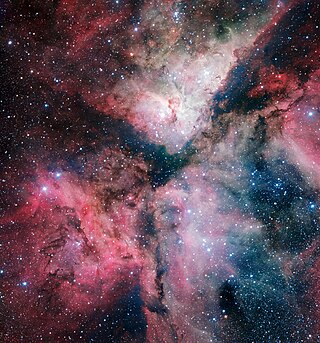
WR 24 is a Wolf-Rayet star in the constellation Carina. It is one of the most luminous stars known. At the edge of naked eye visibility it is also one of the brightest Wolf Rayet stars in the sky.

WR 134 is a variable Wolf-Rayet star located around 6,000 light years away from Earth in the constellation of Cygnus, surrounded by a faint bubble nebula blown by the intense radiation and fast wind from the star. It is five times the radius of the sun, but due to a temperature over 63,000 K it is 400,000 times as luminous as the Sun.
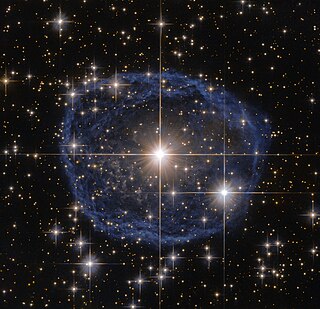
WR 31a, commonly referred to as Hen 3-519, is a Wolf–Rayet (WR) star in the southern constellation of Carina that is surrounded by an expanding Wolf–Rayet nebula. It is not a classical old stripped-envelope WR star, but a young massive star which still has some hydrogen left in its atmosphere.
WR 135 is a variable Wolf-Rayet star located around 6,000 light years away from Earth in the constellation of Cygnus, surrounded by a faint bubble nebula blown by the intense radiation and fast wind from the star. It is just over four times the radius of the sun, but due to a temperature of 63,000 K it is 250,000 times as luminous as the sun.
WR 3 is a Wolf-Rayet star located around 9,500 light years away from Earth in the constellation of Cassiopeia.

HD 151932, also known as WR 78, is a Wolf-Rayet star located in the constellation Scorpius, close to the galactic plane. Its distance is around 1,300 parsecs away from the Earth. Despite being a blue-colored Wolf-Rayet star, it is extremely reddened by interstellar extinction, so its apparent magnitude is brighter for longer-wavelength passbands. HD 151932 lies about 22′ west of the open cluster NGC 6231, the center of the OB association Scorpius OB1; it is not clear whether it is a part of the association or not. With an apparent magnitude of about 6.5, it is one of the few Wolf-Rayet stars that can be seen with the naked eye.
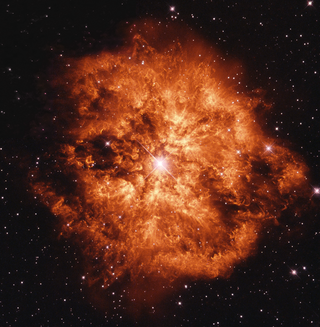
M1-67 is an ejecta nebula that surrounds the Wolf–Rayet star WR 124, which is about 6.4 kpc from Earth in the constellation of Sagitta. It contains dust which is caught up in WR 124's solar wind and which absorbs much of the star's light. It was discovered by American astronomer Paul W. Merrill in 1938, at the same time that he discovered the star it surrounds. It is approximately 6 lightyears across, making it about 20,000 years old.
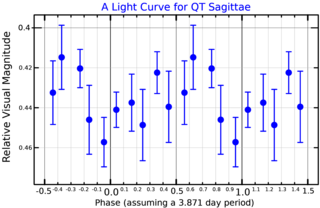
WR 128 is a Wolf–Rayet star located about 9,500 light years away in the constellation of Sagitta. A member of the WN class, WR 128's spectrum resembles that of a WN4 star, but hydrogen is clearly present in the star, making it the only known hydrogen-rich WN4 star in the galaxy. However, similar H-rich very early WN stars can be found in the LMC and especially in the SMC, but the only other galactic examples of this are WR 3 and WR 152.
WR 150 is a Wolf-Rayet star in the constellation of Cygnus. It is one of the early-type carbon sequence (WCE), and is of spectral type WC5. WR 150 is very far from the Earth, being 28,500 light-years from it.
WR 138a is a Wolf-Rayet star in the constellation Cygnus. It is of a very late spectral type of WN9h. The WR is also at the centre of a ring nebula and is a runaway.

WR 120 is a binary containing two Wolf-Rayet stars in the constellation of Scutum, around 10,000 light years away. The primary is a hydrogen-free weak-lined WN7 star, the secondary is a hydrogen-free WN3 or 4 star, and the system is a possible member of the cluster Dolidze 33. From our point of view, WR 120 is reddened by 4.82 magnitudes, and it has the variable designation of V462 Scuti.

HD 326823, also known as V1104 Scorpii, is a binary star containing a unique emission-line star, which is in the midst of transitioning to a nitrogen-rich Wolf-Rayet star, as well as being a candidate Luminous blue variable, located 4,142 light years away in the constellation of Scorpius. The primary is very evolved, because it is composed of almost entirely helium, and only 3% of it is still hydrogen, and it has lost most of its mass to the now-very-massive secondary. The underlying mechanisms and mass transfers in the system are comparable to other W Serpentis systems, such as Beta Lyrae and RY Scuti.












